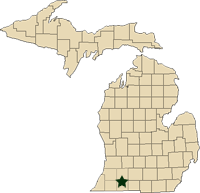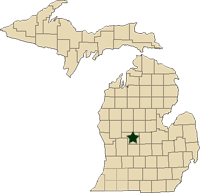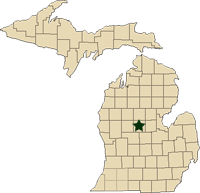Regional reports on Michigan field crops – May 10, 2012
MSU Extension educators’ pest and field crop updates for Michigan.
This week’s regional reports:
- Southwest Michigan – Bruce Mackellar
- West Central Michigan – Fred Springborn
- Central Michigan – Paul Gross
Southwest Michigan – Bruce Mackellar, Michigan State University Extension
|
Weather
Field conditions have been too wet to work for most of the last week. Planting operations resumed on Sunday (May 6) and began again on Wednesday (May 9) on lighter soils following several rainfall events.
Rainfall
Precipitation totals since May 1 ranged from 2 inches near Benton Harbor, Mich., to 0.69 inches near Lawton, Mich. The heaviest rainfall fell to the north of the region, with substantially more precipitation in northern Allegan, Ottawa and Barry counties. With dryer than normal conditions in both the 6 to 10 and 8 to 14 day outlooks, planting operations will be pushing towards a rapid conclusion over the next couple of weeks.
Temperature
Michigan is expected to warm up with both the 6 to 10 and 8 to 14 day outlooks showing warmer than normal conditions. Growing degree day totals across the region averaged 782 base 41 across the 13 weather stations in southwest Michigan. I usually report GDDs base 50 as of May 1 for corn growth stage estimations. We are averaging 111 GDDs base 50 since that date. We normally accumulate around 9.5 GDDs base 50 during the next five-day period. Warmer temperatures in the forecast will push that number ahead quite nicely.
Crops
Early planted corn is at V1 to V2. Warm conditions over the weekend pushed growth ahead. For the most part, early planted corn continues to look good. Herbicides are going on quickly. Annual weed species are emerging quickly, so keep an eye on weed size if you are spraying delayed preemergent herbicides and you will not be able to spray for a while.
In looking at fields, I have been able to find black cutworm larvae that are about 0.75 inches long. The numbers have been fairly low, but their size suggests that moth flight occurred earlier than we expected. Monitor fields for cutworm activity. We also have caught armyworm moths in moderate to high numbers in north central Van Buren County over the last week. While this is mostly a problem for small grains, it could be a problem if your corn field had a cereal cover crop and was recently killed off. Early instar damage can appear as windowpane feeding. Later instar damage appears as ragged-edge feeding symptoms.
I have also seen elevated numbers of Asiatic garden beetle white grubs in Van Buren County. One field examined last week showed that 50 percent of the white grubs found were of that species. We would expect this to be a problem on rotated fields with soybeans or alfalfa. So far, numbers have been low. Watch for corn stands that emerge evenly but become very uneven or that plants begin to die in higher, sandier patches in fields. This will become evident by sidedress time. There are no rescue treatments for grubs, so replanting badly damaged areas and using a soil insecticide would be the only option. Seed treatment at the 250 level did show some protection in research in St. Joseph County in 2008, but the field was planted fairly late. High numbers of Asiatic garden beetle grubs have caused damage to stands with this level of seed treatment over the last couple of years.
Early planted soybeans have emerged and stands look good. Watch for bean leaf beetle damage in early planted fields.
The wheat crop looks good in some areas, rough in others. Most damage is due to cold temperatures and repeated frosts. Most fields are in the boot stage down here. There is some powdery mildew in the lower canopy. We will be moving rapidly into the fungicide application window.
We have caught a significant number of armyworm moths in wheat fields around Bloomingdale, Mich. (44 overnight). Numbers were substantially lower in the Decatur, Mich., area traps (four over the same period). It will pay to scout small grain fields for developing armyworm damage. Watch for ragged-leaf-margin feeding and potential complete defoliation. MSU entomologist Chris DiFonzo's publication on Small grain insect pests lays out thresholds (four or more worms per square foot before heading, two or more worms per square foot after heading to prevent head clipping) and products available for armyworm control in wheat. The largest danger from these pests will be from flag leaf feeding and head clipping much closer to harvest.
Alfalfa harvest will pick up with drier weather. First cutting yields will be way down in many areas due to the frosts. Stunted alfalfa should be cut so that the regrowth can get started. Watch fields for alfalfa weevil, especially the early regrowth, where the thresholds to 25 percent tip feeding injury.
West Central Michigan – Fred Springborn, Michigan State University Extension
|
Weather
One to 2 inches of rain fell in much of the west central region in the past week followed by scattered light showers. A few areas did receive lesser amounts of 0.5 inches while some producers reported 3 inches and more. Field work came to a stop on the heavier soils and in areas that received larger amounts of rain. Field work did continue on the lighter soils between rain showers this week. Temperatures have improved for plant growth; high air temperatures were generally in the mid-60s with a high of 83 degrees recorded at Entrican, Mich., on Thursday (May 3) of last week. Low air temperatures ranged from 36 degrees to the low 50s this week; a scattered light frost was observed this morning (May 10). Low soil temperatures at 2 inches have climbed into the high 40s to low 50s.
Crops
Wheat is at Feekes 9 in many fields, much of the crop is at 8 and a few still at 7. Leaf disease pressure remains quite low in most fields with powdery mildew present, but not threatening the flag leaf, or the leaf below the flag leaf, in all cases I observed this week.
Oatsare variable in growth stage from Feekes 5 up to 7 in early planted fields.
Alfalfa is variable in height and quality. Alfalfa weevil and feeding is present.
Corn is 25 to 30 percent planted. A number of producers were able to get some planting done on the lighter soils yesterday (May 9). I have observed a few fields that have emerged; most are like the corn plot I planted on April 26, which is a day or two yet from spiking through.
Soybean planting has started. As with corn, some areas and producers are planting at a faster pace than others.
Armyworm pheromone traps in Montcalm County caught an average of five moths per trap last week and no black cutworm moths were caught this week.
Central Michigan – Paul Gross, Michigan State University Extension
|
Weather
Scattered showers across the region have slowed planting progress. Farmers have had to pick and choose fields that are dry enough to plant based on variable amounts of rainfall last week. Soil temperatures are in the mid- to high 50s. The northern parts of the region are still getting early morning frost. Good weather is predicted for next week, so planting will resume over the weekend (May 12-13).
Commodity reports
Corn planting will resume this weekend as fields dry out. Early planted corn is emerging with good stands reported. It is estimated that the crop is 45 to 55 percent planted across the region. With a good week next week, the crop will be nearly planted. Burndown herbicide applications are being made.
The soybean crop is being planted along with corn as field conditions allow. There are reports of some of the early planted fields just emerging. It is estimated that the crop is 20 percent planted. Burndown herbicide applications are needed in no-till fields.
The wheat crop is well ahead of schedule. Much of the crop has flag leaves emerged. The warm rains of last week have been very beneficial to many of the fields. Many of the fields with yellow color are beginning to green up. Powdery mildew can be found in most fields at low levels. It will be important to scout wheat fields for armyworms. Moth flights have been very high in some pockets.
The alfalfa crop is progressing and has a PEAK reading of 33 to 35 NDF. It expected that harvest will begin later next week. There are reports of alfalfa weevil feeding in fields in central Michigan. Scout for this pest. Many are expecting yields will be lower this year, but quality should be good. Watch for articles in MSU Extension News for Agriculture for crop progress.
Sugarbeets have emerged very well with no reported problems.
Oat and barley are emerging and looking very good. New alfalfa seedings look very good as well.



 Print
Print Email
Email






